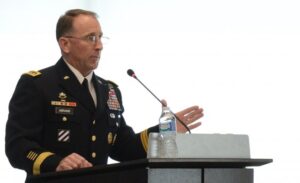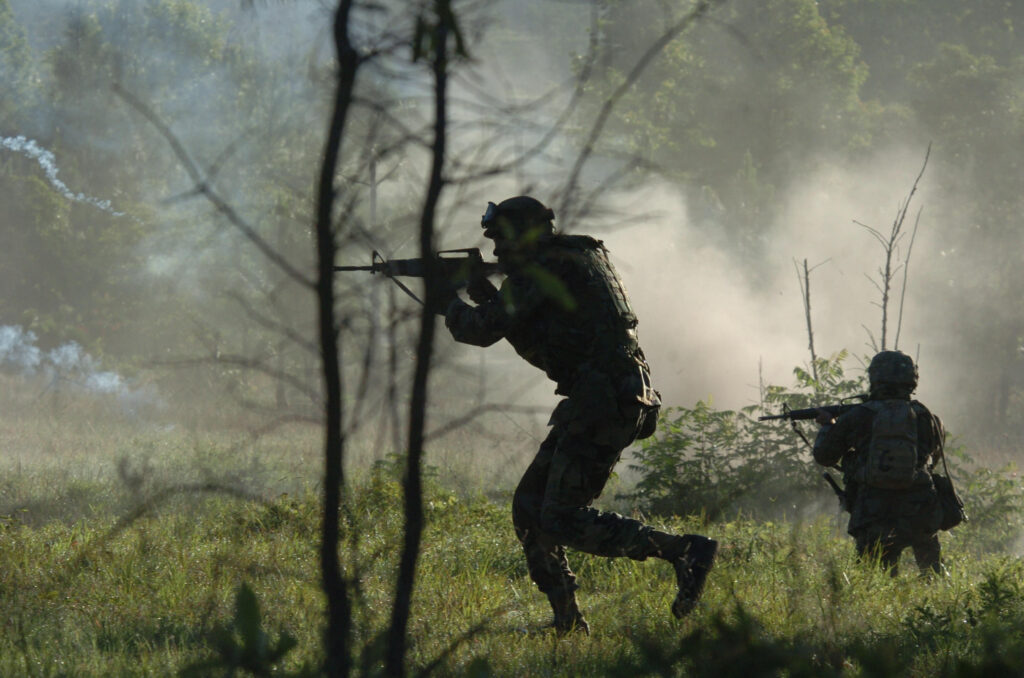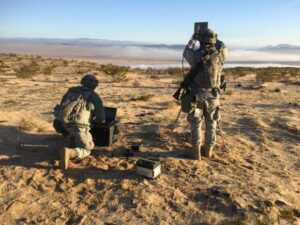
M1 tank at the National Training Center in 2015.
AUSA: In February 2014, when Russian troops seized Crimea, almost no one in the US Army had trained for great power war. But since then, the head of Forces Command told me, every active-duty combat brigade has gone through at least one high-intensity wargame at the famed Combat Training Centers on Fort Irwin, Calif. and Fort Polk, La. 80 percent have gone through twice, and several, three times.

Gen. Robert Abrams
It’s the revived Russian threat that, more than anything, is driving the Army to change: accelerating acquisition, rewriting doctrine and overhauling training. While the Army had looked ahead and begun work on what’s now called the Decisive Action Training Environment (DATE) back in 2011, “things really changed in February, 2014,” Abrams told me at the Association of the US Army conference here. It was that year the first high-intensity wargames (called “rotations”) began.
“80 percent have been through two,” Gen. Robert Abrams told me, “and we’ve got probably four or five that have been through three.” Even troops headed for Afghanistan, Iraq, or Syria get trained on big-war skills before they go – in stark contrast to the past decade of training intensively for counterinsurgency in a particular district. On the flipside, the new training mixes some of the crucial lessons of irregular warfare into the conventional battle.
But you can’t just dust off Cold War training manuals in an era when Russian propaganda, proxies, and Little Green Men strike before the tank divisions invade, and when old-school Katyusha rockets strike targets that drones have pinpointed. “A lot of people have wrongfully assumed that we’ve gone back in time to fight our previous threat models, sort of a high-end conventional force,” Abrams said. “That could not be further from the truth.”

An Opposing Force (OPFOR) vehicle mocked up to look like an enemy machine.
A veteran of the training centers’ Cold War heyday in the 1980s – like Abrams himself –would recognize the terrain, the American armored vehicles mocked-up as Russian tanks, the friendly and “enemy” planes staging simulated airstrikes, he said. They wouldn’t recognize the quadcopters spying on US units, the Opposing Force (OPFOR) soldiers fighting out of uniform as guerrillas, the contractors roleplaying local civilians, the local officials and ostensibly friendly security forces. They wouldn’t recognize the cyber and electronic warfare attacks that can disrupt the high-tech networks, GPS navigation, and constant communications – to the point of micromanagement – that US troops have grown reliant on since 9/11.
All this complexity requires leaders to show much more initiative. “Before, in the ’80s and ’90s, it was very rote,” Abrams said. “You would get there on this day and on Friday, you would do a road march out, and you’d get an order for an attack, and you would go attack. And then, four hours after the attack was done, you’d do an After Action Review, you’d get another order, and you’d get ready do something else. It was all very lockstep.”

Infantry training at the Joint Readiness Training Center, Fort Polk, La.
For example, almost every unit training at Fort Polk used to start on the east side of the base, at landing zone Geronimo, and then advance west. Units at Fort Irwin got to move either east to west or west to east, but other directions were all but unheard of. Now, said Abrams, units have to start in different places and move in different directions, including – and this is apparently a shocker in Combat Training Center culture – north to south. Instead of being standardized, the scenario is different for every unit that arrives.
Nor do you stick to the scenario. In the old days, “if you saw opportunities we did not allow you to deviate” from the scenario, said Abrams. Today, by contrast, “it’s much more continuous, it’s much more free-flowing.” If a commander sees an opening or picks up intelligence – perhaps from conventional scouts, perhaps from talking with the villagers – then he or she can go off-script and seize the opportunity. If that bypasses part of the planned training scenario, so be it, Abrams told me. The operations center staff at the training centers is now flexible enough to insert alternative ways to test any skills that were missed.

Cyber soldiers from the 780th Military Intelligence Brigade in the desert at the National Training Center.
Not all commanders thrive in this environment. In one wargame, the brigadier sent one of his battalions ahead to scout some crucial passes before the main body attacked them. When the battalion got there, it found no enemy: The passes were unguarded. While the battalion commander’s orders were to scout, not seize, the larger purpose – what’s called “commander’s intent” – was clearly to get the brigade through the passes.
But the Opposing Force was messing with communications, which meant the battalion commander couldn’t easily check with his superiors. Instead of seizing the opportunity and the passes, Abrams said, “he sat for 10 hours wanting to reestablish good coms with his higher headquarters and make sure he wasn’t getting too far out in front.”
By the time the battalion commander felt confident enough to go ahead, the OPFOR had moved two companies into defensive positions. What could have been an unopposed cakewalk turned into an all-night fight.
“This is much, much more difficult than when I was a company commander, an operations officer, or a battalion commander,” Abrams said. When old soldiers complain about the changes, “I tell them all, hey, if you thought it was hard before, you ain’t seen nothing yet.”
Army eyes TBI monitoring, wearable tech for soldiers in high-risk billets
“We are also looking at what additional personal protective equipment we can provide to our folks, especially instructors and others who are routinely exposed to blast pressure,” said Army Secretary Christine Wormuth.


























